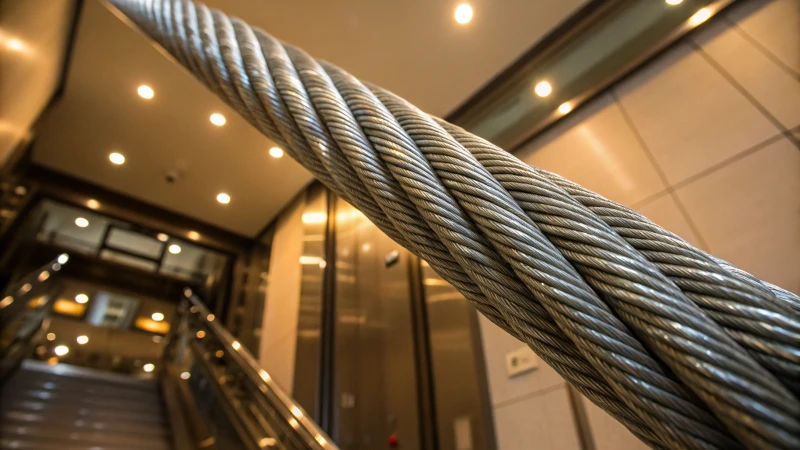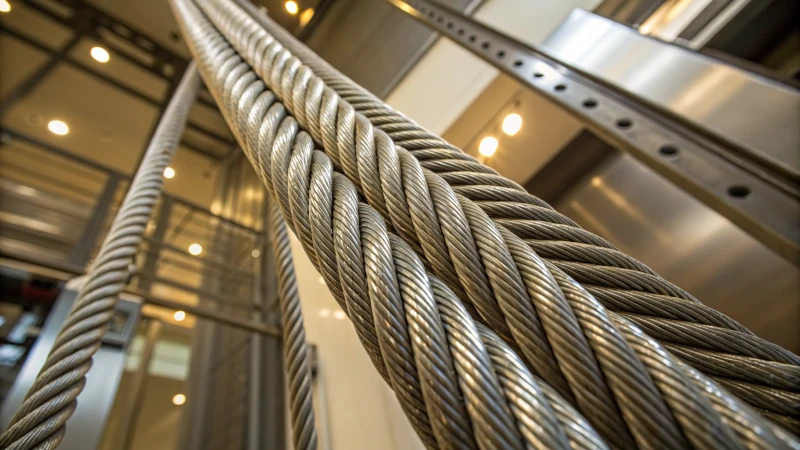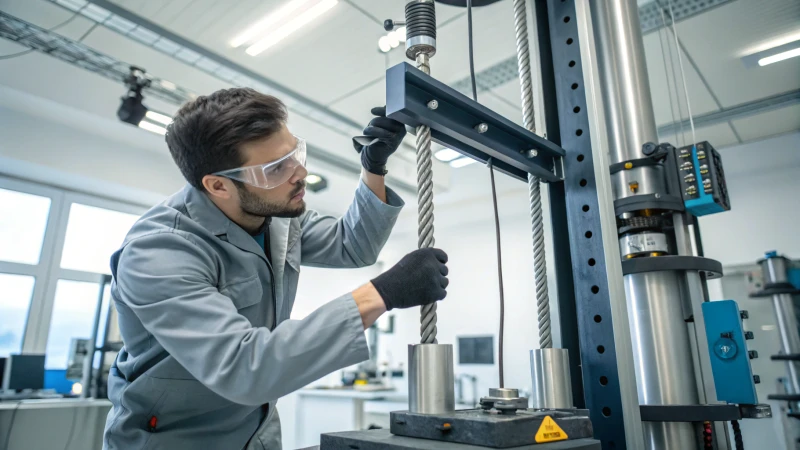
Imagine being whisked upwards at breakneck speeds, feeling the smooth glide of a high-speed elevator.
Steel wire ropes are perfect for high-speed elevators because they offer incredible tensile strength, flexibility, and fatigue resistance. With their 6x36 construction, these ropes endure intense dynamic forces and last 30%-40% longer than traditional options, ensuring reliability and safety.
I remember standing in awe the first time I rode a high-speed elevator. As it soared upward, I couldn't help but think about what goes into making such a ride possible. Steel wire ropes play a crucial role here. Unlike chains, these ropes are crafted to endure the dynamic stresses of rapid movement. They're not just strong; they're flexible and resilient, adhering to rigorous ISO standards. This means they're designed to handle the intense demands of high-speed travel while ensuring a smooth and safe journey every time. It's this combination of durability and precision engineering that makes them indispensable in modern skyscrapers.
Steel wire ropes have superior flexibility for elevators.True
Steel wire ropes are designed to bend easily, enhancing elevator performance.
Chains outperform steel wire ropes in high-speed elevators.False
Steel wire ropes offer better tensile strength and fatigue resistance than chains.
How Do Steel Wire Ropes Enhance Elevator Safety?
Steel wire ropes are the unsung heroes of elevator safety, seamlessly blending strength and flexibility to keep us moving smoothly. But how do they really make our elevator rides safer? Let's delve into their fascinating role in vertical transportation.
Steel wire ropes enhance elevator safety by offering robust tensile strength and adaptability, essential for managing the dynamic forces during elevator motion. Their resilience ensures dependable operation, minimizing maintenance needs and boosting overall safety.

Understanding the Mechanics of Steel Wire Ropes in Elevators
Imagine stepping into an elevator, the door sliding shut with a reassuring click, and then feeling the gentle rise as it lifts you skyward. What you don't see is the silent work of steel wire ropes behind the scenes. These ropes are marvels of engineering, designed to carry heavy loads with ease while bending and flexing to the elevator's every move. I remember the first time I learned about the 6×36 construction1 used in these ropes—it's a perfect balance of strength and flexibility, which is crucial for that smooth ride we often take for granted.
| Feature | Benefit |
|---|---|
| High tensile strength | Supports heavy loads, preventing breakage. |
| Flexibility | Adapts to rapid movements without snapping. |
| Durability | Reduces wear and tear, enhancing longevity. |
Impact of Material Choice on Safety
I recall a conversation with a friend who works in elevator maintenance. He emphasized how stainless steel is preferred for elevator ropes due to its corrosion resistance2. This makes perfect sense because these ropes must perform reliably even in environments where moisture and other corrosive elements are present.
- Fatigue Resistance: I was fascinated to learn that stainless steel's ability to withstand repeated stress makes it a go-to for high-use elevators. This reduces the risk of sudden failures, keeping passengers safe.
- Performance Data: Studies like those conforming to ISO 4344 show that stainless steel ropes outlast traditional ones by 30%-40%, providing a trustworthy solution for continuous elevator operation.
How Dynamic Forces Affect Elevator Ropes
I often think about the dynamic forces at play when an elevator accelerates or decelerates. Steel wire ropes are engineered to endure these forces without compromising their structural integrity.
- Load Capacity: High-speed elevators particularly need ropes that can withstand extreme loads. The tensile strength3 of steel wire ropes ensures they meet these requirements safely.
- Safety Standards: By adhering to strict safety standards like ISO, we can be assured that these ropes meet essential performance criteria.
These aspects collectively contribute to the safety and reliability of modern elevators, making steel wire ropes a cornerstone of secure vertical transportation.
Steel wire ropes in elevators prevent breakage.True
High tensile strength supports heavy loads, preventing rope breakage.
Stainless steel ropes last 10% longer than traditional ones.False
They last 30%-40% longer, according to ISO 4344 testing.
Why Choose Stainless Steel Ropes for Tough Jobs?
Have you ever wondered why stainless steel ropes are the go-to choice for tough jobs? Dive in to discover their incredible benefits!
Stainless steel ropes are prized for their exceptional corrosion resistance, high tensile strength, and outstanding durability, making them perfect for demanding environments like marine, construction, and industrial sectors.

Corrosion Resistance
I remember the first time I saw stainless steel ropes in action on a ship. The salty sea air was relentless, yet these ropes stood their ground without a hint of rust. This resilience comes from their unique composition; the chromium in stainless steel creates a protective layer that fights off corrosion, making them perfect for marine environments4. Whether it's shipbuilding or offshore drilling, these ropes last where others falter.
Tensile Strength
Back when I was involved in a high-rise construction project, we needed ropes that could handle extreme loads without snapping. Stainless steel ropes were our answer. With tensile strengths soaring over 2000 MPa, they confidently carried the weight of high-speed elevators and crane hoists. It was reassuring to know that they wouldn’t give way under pressure, ensuring the safety of everyone on site.
| Type | Tensile Strength (MPa) |
|---|---|
| Stainless Steel | 2000+ |
| Galvanized Steel | 1500 - 1800 |
Durability and Flexibility
One thing I've learned over the years is the value of durability, especially when it comes to equipment that faces constant wear. Stainless steel ropes offer this durability alongside impressive flexibility. Imagine ropes in industrial machinery5 that endure repetitive motion day in and day out—they remain steadfast. Their 6×36 construction provides a balance between strength and flexibility, stretching their service life by up to 40% compared to older models.
Applications Across Industries
The versatility of stainless steel ropes is unmatched:
- Construction: Ideal for rigging and lifting tasks, ensuring safety and strength.
- Marine: Perfect for mooring lines and lifelines, thanks to their corrosion resistance.
- Industrial: Essential for conveyor belts and heavy machinery6, where durability is key.
These benefits make stainless steel ropes an indispensable part of many operations. Their reliability and performance are well worth the investment, leading to long-term savings and improved efficiency in your projects.
Stainless steel ropes resist corrosion better than galvanized steel.True
The chromium in stainless steel forms a protective oxide film, enhancing resistance.
Stainless steel ropes have lower tensile strength than galvanized steel.False
Stainless steel has a tensile strength of 2000+ MPa, higher than galvanized.
How Do We Test the Performance of Elevator Ropes?
Ever wondered what keeps those elevator rides so smooth and safe? It's all about the ropes! Join me as I delve into the fascinating world of elevator rope testing.
To test elevator ropes, we focus on tensile strength, fatigue resistance, and elongation. These rigorous tests ensure ropes withstand dynamic forces and extreme loads, aligning with international safety standards like ISO 4344.

The Journey of Testing Elevator Ropes
I remember the first time I really thought about elevator ropes. It was during a college field trip to a high-rise building construction site. Watching those massive elevators glide up and down made me wonder, "How do these ropes hold up under all that pressure?" It turns out, it's all about rigorous testing.
Tensile Strength Testing
Tensile strength tests are where we start. Picture this: you’re trying to break a rubber band by pulling it from both ends. That's essentially what we do with elevator ropes, albeit on a much larger scale. By applying controlled tension7 until they snap, we ensure they can handle maximum loads without giving way.
Fatigue Resistance Evaluation
Next comes the fatigue resistance test. Imagine repeatedly stretching that rubber band—over and over again. This test simulates the relentless up-and-down motion of an elevator. It’s like a grueling workout for the ropes, ensuring they don't wear out too soon. The 6×36 construction is often our go-to choice for its balance of flexibility and durability.
Elongation and Flexibility Tests
Then there are the elongation tests. Think of how a piece of dough stretches when pulled—this test measures how much a rope can stretch under weight without losing its shape or snapping. Flexibility tests8 are conducted by bending the rope over pulleys repeatedly, making sure it doesn't lose its strength.
Compliance with International Standards
Adhering to standards like ISO 4344 is crucial. These standards are like a rulebook for safety and performance, ensuring the ropes are fit for various environments. It reminds me of studying for exams back in school—meeting these standards ensures everything runs smoothly.
Visual Inspections and Non-Destructive Testing
Visual inspections and non-destructive testing are our final checkpoints. By meticulously scanning for any surface defects or internal flaws, we guarantee that nothing gets past our watchful eyes. Techniques like magnetic flux leakage9 help us catch what’s hidden beneath the surface without damaging the ropes.
Summary Table of Testing Methods
| Test Type | Purpose | Example Standard |
|---|---|---|
| Tensile Strength | Assess maximum load capacity | ISO 4344 |
| Fatigue Resistance | Evaluate longevity under cyclic stress | Company-specific |
| Elongation and Flexibility | Measure stretch and adaptability under load | Custom test protocols |
| Visual Inspections | Identify surface defects | In-house procedures |
| Non-Destructive Testing | Detect internal flaws without damaging the rope | Magnetic flux leakage |
These processes might sound technical, but they ensure our elevator rides remain safe and reliable. After all, just like those college exams, getting it right means passing with flying colors every single time.
Elevator ropes are tested for tensile strength by stretching.True
Tensile tests involve applying controlled tension to assess load capacity.
Visual inspections are not part of elevator rope testing.False
Visual inspections check for defects and degradation on the rope surface.
Why are chains less suitable for high-speed elevators?
Let me tell you why chains just don't cut it for high-speed elevators and why wire ropes are the real MVPs.
Chains aren't ideal for high-speed elevators because they're heavy and inflexible, making them inefficient and less reliable. Wire ropes, however, offer superior strength and flexibility, making them a better choice for smooth and safe elevator operations.

Material Properties
Imagine you're cruising down the highway in a sleek sports car versus a bulky truck. That's the difference between wire ropes and chains in high-speed elevators. Chains, made from carbon steel or alloy, are the trucks here—strong but cumbersome, lacking the flexibility to gracefully glide through rapid elevator journeys. Their hefty weight also means more energy gets consumed, much like a gas-guzzler on a road trip. On the other hand, wire ropes are like those sports cars—light and nimble, engineered with multiple strands to bend and flex effortlessly.
| Feature | Chains | Wire Ropes |
|---|---|---|
| Flexibility | Low | High |
| Weight | Heavy | Light |
| Tensile Strength | Adequate | Superior |
Performance in Dynamic Conditions
Think back to that time when I tried running a marathon without training—it didn't end well! Chains experience similar struggles with the stop-and-go demands of high-speed elevators. This constant pressure can wear them down quickly, shortening their lifespan like those shoes I wore out trying to keep up with my healthier friends. Wire ropes, particularly those with a 6×36 construction10, are built to handle this dynamic stress like a seasoned marathoner, evenly distributing tension across their strands.
Safety Concerns
Safety is everything, right? I remember once trying to assemble a DIY bookshelf without reading the instructions first—it was risky business! Chains can be like that, prone to unexpected deformations under heavy loads, leading to sudden failures. In contrast, wire ropes offer better safety11 margins due to their ability to show signs of wear over time, allowing for timely maintenance.
Efficiency and Maintenance
If you've ever owned an older car, you'll appreciate this: wire ropes require less maintenance than chains, thanks to their resistance to rust and fatigue. This means fewer trips to the mechanic—erm, I mean less downtime for elevators—and lower maintenance costs in the long run. Their longer service life12 makes wire ropes not just efficient but also cost-effective.
In summary, while chains have their strengths in certain mechanical systems, high-speed elevators demand the agility and resilience of wire ropes to ensure safe, efficient travel from floor to floor. So next time you step into an elevator zipping upwards, remember it's the wire ropes working hard behind the scenes.
Chains are heavier than wire ropes in elevators.True
Chains have a higher weight compared to wire ropes, affecting energy use.
Wire ropes require more maintenance than chains.False
Wire ropes need less maintenance due to better corrosion and fatigue resistance.
Conclusion
Steel wire ropes are essential for high-speed elevators due to their tensile strength, flexibility, and fatigue resistance, ensuring safety and reliability in vertical transportation.
-
Learn about the advantages of 6×36 construction in providing the right balance of strength and flexibility for elevator safety. ↩
-
Understand why stainless steel's corrosion resistance is vital for maintaining the longevity and safety of elevator ropes. ↩
-
Explore how high tensile strength in steel wire ropes supports heavy loads and enhances elevator safety. ↩
-
Explore how stainless steel's unique composition offers superior corrosion resistance, crucial for marine applications. ↩
-
Understand the benefits of stainless steel ropes in maintaining durability and flexibility under industrial stress. ↩
-
Discover how stainless steel ropes are applied in heavy machinery to improve performance and longevity. ↩
-
This link explains how tensile strength tests are performed on elevator ropes, detailing procedures and standards. ↩
-
Explore how flexibility tests ensure elevator ropes maintain performance over pulleys. ↩
-
Learn about non-destructive testing methods like magnetic flux leakage for internal flaw detection. ↩
-
Learn about the advantages of 6×36 construction in wire ropes for enhancing flexibility and strength. ↩
-
Discover why wire ropes offer better safety features compared to chains in dynamic applications. ↩
-
Find out how the durability of wire ropes leads to lower maintenance expenses over time. ↩

